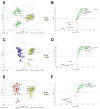1H NMR-Based Metabolomics Reveals the Intrinsic Interaction of Age, Plasma Signature Metabolites, and Nutrient Intake in the Longevity Population in Guangxi, China
- PMID: 35745269
- PMCID: PMC9227029
- DOI: 10.3390/nu14122539
1H NMR-Based Metabolomics Reveals the Intrinsic Interaction of Age, Plasma Signature Metabolites, and Nutrient Intake in the Longevity Population in Guangxi, China
Abstract
Health and longevity populations have distinct metabolic and nutrient intake profiles. However, the relationship between biomarkers of longevity-related metabolites and dietary nutrient intake profiles, as well as metabolic markers associated with longevity features, have not been fully elucidated. Therefore, 1H nuclear magnetic resonance (1H NMR)-based plasma metabolomics profiling was conducted in the present study to identify potential metabolites which can be used as specific markers for the evaluation of healthy aging. Plasma samples were obtained from centenarians and nonagenarians from the longevous region, and elderly participants aged 60-89 from the longevous region, as well as a low centenarian ratio region. The results showed that participants from longevous regions exhibited higher plasma levels of citrate, tyrosine, choline, carnitine, and valine, as well as lower contents of VLDL, lactate, alanine, N-acetyl glycoprotein (NAG), trimethylamine oxide (TMAO), α-glucose, β-glucose, and unsaturated lipids. The differential plasma metabolites were associated with an alteration in glycolysis/gluconeogenesis; aminoacyl-tRNA biosynthesis; alanine, aspartate, and glutamate metabolism; and phenylalanine, tyrosine, and tryptophan biosynthesis in participants from longevous regions. The signature metabolites were associated with higher dietary fiber intake, as well as lower energy and fat intake. The results of the present study demonstrate key longevity signature metabolites in plasma, and the dietary patterns identified provide a basis for further health and longevity research.
Keywords: 1H NMR; centenarians; healthy aging; longevity; metabolomic profiling; nutrient intake.
Conflict of interest statement
The authors declare no conflict of interest.
Figures







References
-
- Estruch R., Ros E., Salas-Salvado J., Covas M.I., Corella D., Aros F., Gomez-Gracia E., Ruiz-Gutierrez V., Fiol M., Lapetra J., et al. Retraction and Republication: Primary Prevention of Cardiovascular Disease with a Mediterranean Diet. N. Engl. J. Med. 2018;378:2441–2442. doi: 10.1056/NEJMc1806491. - DOI - PubMed
MeSH terms
Substances
LinkOut - more resources
Full Text Sources

